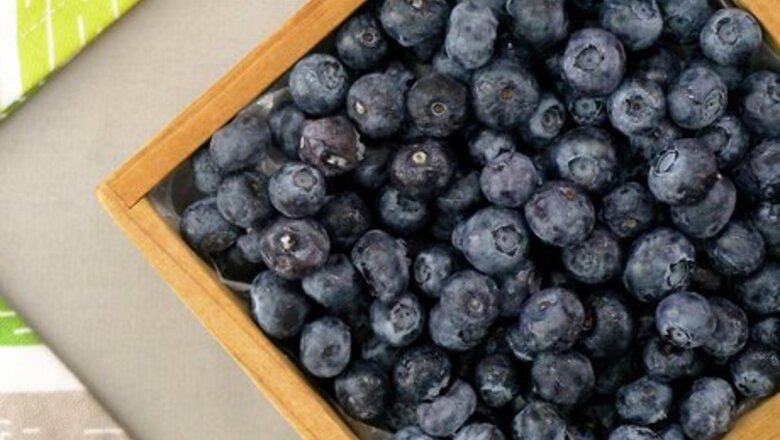
views
Getting the Most Nutrients from Blueberries
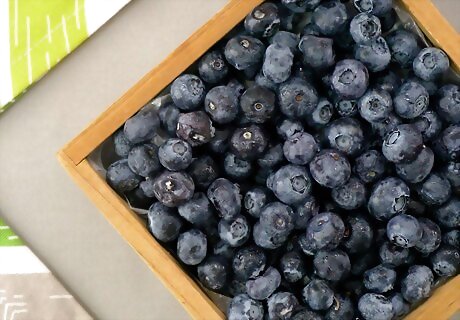
Choose organic. To get the most nutritional benefits out of this healthy fruit, choose organic blueberries. That’s true of most fruits and vegetables, and blueberries are no different! Conventional blueberries have been found to contain lower amounts of anthocyanin antioxidants than organic blueberries do. Antioxidants are ingredients that combat free radicals in the body that can damage cells and DNA. Organic blueberries also carry less risk of trace elements of pesticide, which can have a negative impact on health. Appreciate the power of blueberries. Blueberries are considered one of the world’s healthiest foods because they contain antioxidants. They are known as a superfood! Non-organic blueberries are still good for you. They just aren’t as good for you as the organic variety, which is usually a little more expensive.
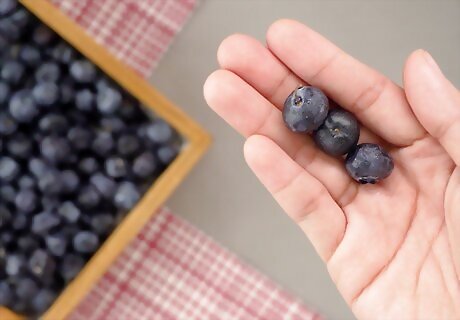
Eat blueberries raw. As with many foods, you will obtain the greatest health benefits from blueberries if you eat them raw. Cooked blueberries still have some health benefits but, say, blueberries baked into pancakes won’t have all of the nutritional flavor or nutritional benefits of the raw fruit. The other issue with cooking blueberries is that you end up with the sugar that baked dessert or breakfast recipes call for. Don’t think that processed package of blueberry muffins will be that good for you! Blueberries are the second most popular fruit in the United States. Only strawberries are consumed more.
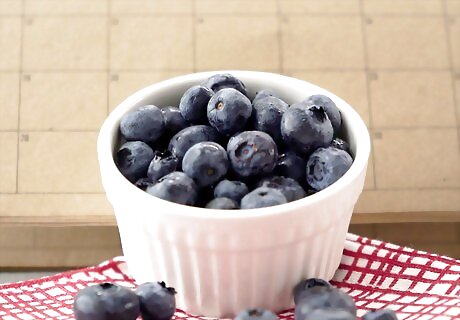
Eat blueberries every day. In order to truly reap the health benefits of blueberries, it’s important to eat them consistently and in fairly large quantities. Studies have documented health benefits in people who eat between 2 and 2.5 cups of blueberries every day. Blueberries are considered on par with strawberries and pomegranates in antioxidant capacity. At least three times a week is a good place to start. Some diabetics who have eaten at least three servings of blueberries every day reported improvement in their body’s ability to regulate blood sugar. Healthier eating plans often recommend between 5-10 servings of fruits and vegetables every day. Some government organizations recommend a little less. The bottom line, though, is that you can’t go wrong by adding more fruits and vegetables into your diet and removing processed foods from it! To gain the benefit of blueberries, though, you need to eat them regularly.
Using Blueberries to Improve Health
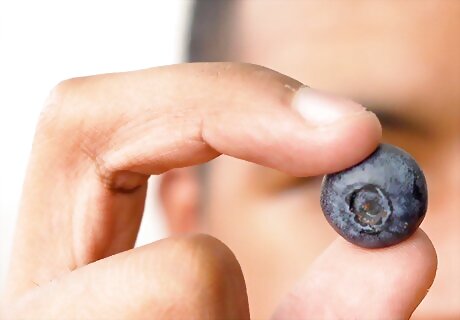
Improve your eyesight. People who struggle with poor eyesight may want to turn to blueberries for help. Blueberries have been shown to protect the retina of the eye from oxygen damage and unwanted sunlight. Blueberries won’t add a lot of calories into your day as they help improve your other health functions, including the eyes. One cup of blueberries (148 grams) has only 80 calories! Blueberries are packed with nutrients, including vitamins C and K, manganese, fiber, and copper.

Protect your heart with blueberries. Those concerned about heart health might also ingest blueberries. As with any health matter, though, always check with your doctor first. Blueberries have been found to lower the risk of developing heart disease in various studies. There are many reasons to add them to your daily diet. Blueberries are good for the heart because they both relax and regulate the vascular wall’s arterial elasticity. Blueberries also have a positive effect on blood pressure. Blueberries also improve heart health by helping with blood flow.

Improve your memory. Blueberries are great for older adults who might be struggling with memory loss as well as people of all ages hoping to improve their memories or stave off the aging process. In one study, people with an average age of 76 ate blueberries every day for a 12-week period. The study demonstrated that the boost to memory can come fast. The adults who ate blueberries performed better on cognitive tests at the end of the study period compared to adults who did not eat blueberries. The anthocyanin in blueberries can also help prevent Alzheimer’s Disease or dementia by stimulating nerve growth in your brain and improving communication between the nerve cell processes in the brain, slowing aging.

Eat blueberries to lower blood sugar. Blueberries are a good food for many diabetics or people hoping to lower their blood sugar. Blueberries have a low glycemic index. This is a method used to determine the effect a food will have on blood sugar levels after it’s digested. Strive for foods with a GI that is 50 or below. Blueberries fall in the range of 40-53. This is actually less than blackberries, strawberries, and raspberries. However, blueberries are said to have a positive effect on people with type 2 diabetes. In three months time, blood sugar levels showed positive improvement in some studies. Blueberries also contain catechins that can assist with weight loss, especially around the belly.

Eat blueberries in the fight against cancer. Blueberries are considered a superfood because they are believed to protect the body against cancer. The antioxidants in blueberries combat what are called free radicals in the digestive tract, and these can cause cancer. Blueberries are believed to help protect the body against certain kinds of cancers, such as colon cancer. Blueberries are believed to help protect the body from pollution, sun exposure and pesticides. Blueberries also protect the cells against toxic heavy metal damage from heavy metals such as cadmium.
Picking, Storing, and Eating Blueberries

Identify different kinds of blueberries. Blueberries are part of the Ericaceae plant family and the Vaccinium genus. There are three groups of blueberries that get the most attention. Highbush blueberries are the type of blueberries you usually see in the grocery store. They grow 12 feet in height and are hybridized to produce larger berries for consumers. Lowbush blueberries are commonly called wild blueberries. They produce smaller berries and are usually found growing in the wild. More species of blueberries are native to North America than any other continent, and blueberries were used by many Native American tribes. Wild blueberries are very strong in nutrients. Rabbiteye blueberries are native to the southern United States. They are sometimes cultivated and their plants grow up to 4 to 10 feet. Blueberries are found on all three continents.

Pick firm berries. Choose blueberries that are not too mushy and that have a vibrant color with a whitish bloom. In order to determine if the berries are moldy or damaged, shake their container to see if they move more freely. If they do, they are likely firmer. Skip blueberries that seem watery or full in color. Water causes blueberries to decay. You don’t want to eat decayed blueberries. Shake a frozen bag of the berries to make sure they are not clumped together, which can be an indication that they were thawed and refrozen. Blueberries are cultivated in the United States from May through October.

Store the blueberries. To store blueberries, first remove any of the crushed or spoiled berries from the carton. Don’t wash the berries until you’re just about to eat them because washing will make the berries’ skins degrade more quickly by removing their blooms. Blueberries can keep in a refrigerated covered container for about three days. A typical plastic container can work well. As with most fruits, blueberries will spoil more quickly if they are left out at room temperature.

Freeze the berries. Wash the berries, and remove any damaged ones before you freeze the berries. Spread the berries out on a cookie sheet for freezing if you have space as this will allow for uniform texture. Once the berries are frozen, you can put them in a plastic bag for further storage in the freezer. Thaw the berries and drain them before using. Blueberries are healthy naturally, but some researchers believe the nutritional benefits of them increase if you freeze them. One researcher found that the antioxidant levels in frozen blueberries increased. The blueberries were frozen for one, three and five months. The science behind this is that the ice crystals from the freezing process disrupt the plant tissue’s structure, making an antioxidant more available that is called anthocyanin. Freeze the blueberries at temperatures of 0 degrees Fahrenheit or -17 degrees Celsius. Anthocyanins help to protect various systems in the body from illness. Anthocyanin is also the ingredient that gives blueberries their vibrant color!

Create blueberry dishes. There are many ways you can eat blueberries. The possibilities are endless! Some are healthier than others, though. Put frozen blueberries in a smoothie or breakfast shake. Add them to cold breakfast cereals or put them in yogurt. Add blueberries to peach crisp, granola, quinoa cereal, or fresh peaches and other fruit. The best way to eat them, though: Raw and by themselves. Many people add blueberries to baked goods, like muffins, pies, and pancakes, but this is a less healthy way to eat them. Pour the blueberries into a small bowl with heavy cream.




















Comments
0 comment